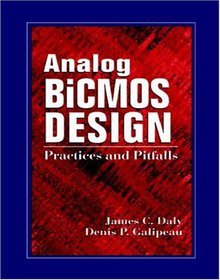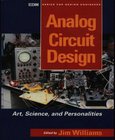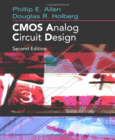Analog BiCMOS Design
Practices and Pitfalls

Book Details:
| Publisher: | CRC Press |
| Series: | CRC Press , Practice |
| Author: | James C. Daly |
| Edition: | 1 |
| ISBN-10: | 0849302471 |
| ISBN-13: | 9780849302473 |
| Pages: | 232 |
| Published: | Dec 20 1999 |
| Posted: | Nov 19 2014 |
| Language: | English |
| Book format: | |
| Book size: | 2.48 MB |
Book Description:
Integrated circuits (ICs) don't always work the first time. Many things can and do go wrong in analog circuit designs. There are a number of common errors that often require costly chip redesign and refabrication, all of which can be avoided when designers are aware of the pitfalls. To realize success, IC designers need a complete toolbox-a toolbox filled not only with a solid background in electronics, design concepts and analysis skills, but also with the most valuable tool of all: experience. Analog BiCMOS Design offers IC design engineers the learning equivalent to decades of practical experience. Culled from the careers of practicing engineers, it presents the most effective methods and the pitfalls most frequently encountered in the design of biCMOS integrated circuits. Accessible to anyone who has taken a course in electronics, this book covers the basic design of bandgap voltage references, current mirrors, amplifiers, and comparators. It reviews common design errors often overlooked and offers design techniques used to remedy those problems.With its complete coverage of basic circuit building blocks, full details of common design pitfalls, and a compendium of design and layout problems and solutions, Analog BiCMOS Design is the perfect reference for IC designers and engineers, fledgling and experienced alike. Read it to reinforce your background, browse it for ideas on avoiding pitfalls, and when you run into a problem, use it to find a solution.
Download Link:
Related Books:
Analog Circuit Design
Art, Science and Personalities
Analog circuit design is a very personalized discipline. To be sure, everyone's bound by the same physics and mathematics, but there is no single right way for those tools to be applied to solve a problem. Practitioners of analog design are noted for their individuality. Three of the four introductions that follow are by acknowledged masters of the analog art and deal with analog's place in a world that seems overwhelmed by digital electronics. Each of those three authors gives a highly personal viewpoint that can't be objectively proven right or wrong, but that is the way it is in many aspects of analog design. The remaining introduction, which appears first, does not directly deal with analog electronics at all. However, it does illustrate the matr...
CMOS Analog Circuit Design
2nd Edition
After years of anticipation, respected authors Phil Allen and Doug Holberg bring you the second edition of their popular textbook, CMOS Analog Circuit Design. From the forefront of CMOS technology, Phil and Doug have combined their expertise as engineers and academics to present a cutting-edge and effective overview of the principles and techniques for designing circuits. Their two main goals are: to mix the academic and practical viewpoints in a treatment that is neither superficial nor overly detailed and to teach analog integrated circuit design with a hierarchically organized approach. Most of the techniques and principles presented in the seco...
CMOS Analog Circuit Design
This text presents the principles and techniques for designing analog circuits to be implemented in a CMOS technology. The level is appropriate for seniors and graduate students familiar with basic electronics, including biasing, modeling, circuit analysis, and some familiarity with frequency response. Students learn the methodology of analog integrated circuit design through a hierarchically-oriented approach to the subject that provides thorough background and practical guidance for designing CMOS analog circuits, including modeling, simulation, and testing. The authors' vast industrial experience and knowledge is reflected in the circuits, techniques, and principles presented. They even identify the many common pitfalls that lie in the path of the...
2007 - 2021 © eBooks-IT.org



